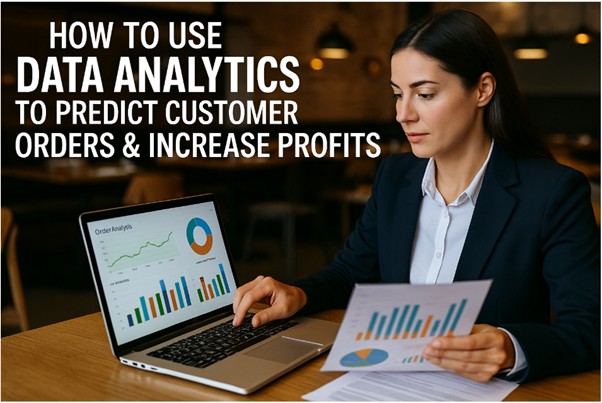
How to Use Data Analytics to Predict Customer Orders & Increase Profits
In today’s fast-paced restaurant industry, instinct and tradition are no longer enough. Successful restaurateurs use data analytics to drive smarter decisions, reduce waste, and maximise profits. From identifying your best-selling dish on a rainy Tuesday to predicting the next big trend in desserts, data transforms how the food business works.
Chef Shajahan M Abdul, founder of Restro Consultants Pvt Ltd (RCPL), said, “Restaurants that understand their data understand their customers. And those that understand their customers always stay ahead.”
So, how exactly can restaurants
use data analytics to predict customer orders and increase revenue? Let’s break
it down.
What is Data Analytics in a
Restaurant Context?
Data analytics in restaurants
involves collecting, organising, and interpreting information from various
sources—sales, inventory, customer preferences, delivery platforms, and weather
reports—to improve decision-making.
Chef Abdul explains, “Every
order placed, table reserved, and review left tells a story. Data analytics
helps you read that story clearly and act on it.”
Why Predictive Analytics
Matters
Predictive analytics is a
specific subset of data analytics that uses historical data to forecast future
behaviour. In a restaurant, this could mean:
Restaurant consultants at RCPL
report that restaurants using predictive analytics effectively see a 15%–25%
increase in profitability over time.
How to Start Using Data
Analytics to Predict Orders
1. Centralize Your Data Sources
The first step is ensuring you
have the right tools to collect data. Sources include:
Restro Consultants Pvt Ltd
(RCPL) helps restaurants integrate these tools into one unified dashboard for
better visibility and actionability.
Chef Shajahan M Abdul notes,
“If your data is scattered, your decisions will be too. Centralization is step
one to smart forecasting.”
2. Identify Patterns in
Customer Behaviour
Look for trends in your
historical sales data:
By analyzing these insights,
you can predict what customers will likely order on similar future days.
Chef Abdul shares an example:
“One of our RCPL clients saw a 30% rise in paratha orders on Friday evenings.
We used that insight to run targeted promotions—and revenue spiked even more.”
3. Optimize Menu Offerings
Based on Insights
With predictive analytics, you
can identify:
This makes your menu not just
appealing but also strategic.
Restaurant consultants at RCPL
often perform quarterly menu audits using sales and customer data to refine
offerings that align with demand and profitability.
4. Personalize Marketing and
Offers
If you know a regular guest
always orders a butter chicken thali on Thursdays, your CRM can trigger a personalised
WhatsApp or SMS reminder with a 10% discount.
Predictive analytics helps
automate such personalisation at scale.
Chef Shajahan M Abdul says,
“The future of loyalty isn’t points—it’s personalisation. Customers return
where they feel understood.”
5. Forecast Inventory &
Reduce Waste
By predicting orders, you can
also forecast ingredient usage. This helps reduce:
Restro Consultants Pvt Ltd
(RCPL) sets up innovative inventory systems that align with sales forecasts so
that stock levels are accurate and just-in-time.
6. Improve Staffing Efficiency
Staffing too many employees
during a slow shift eats into profits. Too few during a rush compromises
service.
By predicting high and low
traffic hours, you can create smarter rosters, reduce payroll costs, and
improve guest experience.
Chef Abdul adds, “It’s not
about working harder—working smarter with the right team at the right time.”
How AI Takes Predictive
Analytics Further
Many modern platforms now use
AI (artificial intelligence) to:
RCPL partners with leading tech
vendors to bring these AI-powered insights into daily restaurant operations.
Case Studies from RCPL
Overcoming Common Challenges
❌ Data Overload
Not all data is valid. Focus on
KPIs that affect revenue, such as average order value, top-selling items, and
customer retention rate.
❌ Lack of Tech Infrastructure
Many restaurants still rely on
manual logs. Upgrading to smart POS and integrated CRM is essential; restaurant
consultants can help smooth this transition.
❌ Resistance to Change
Teams may resist new systems.
Proper training and showing them the results (e.g., tips increase with smarter
upselling) help gain buy-in.
Final Thoughts from Chef
Shajahan M Abdul
Data isn’t a luxury in a highly
competitive industry —it’s a necessity. Predictive analytics helps you
understand your customers, reduce guesswork, and boost real-time profits.
As Chef Shajahan M Abdul puts it:
“The most profitable restaurants don’t just cook—they calculate. And then, they
connect.”
With expert support from
restaurant consultants at Restro Consultants Pvt Ltd (RCPL), even small and
mid-sized restaurants can use data to make big, bold, and profitable decisions.
Chef Abdul © Copyright 2024. All rights reserved.